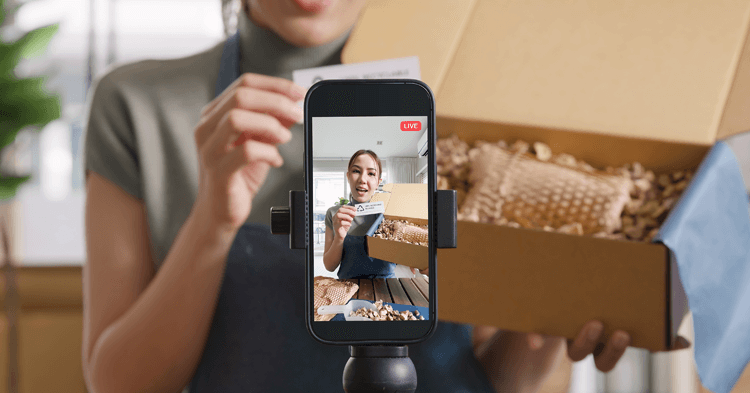Social Media Marketing for Small Business: The Ultimate Guide
Social media can help you increase brand awareness, drive sales and build customer loyalty. Maybe that’s why over 30 million small businesses use social media in their marketing strategy.
Still, it can be hard to get noticed with all the noise.
Whatever your level of experience in social media, it will take the right strategy to boost your brand, engage your audience and skyrocket your success. Here’s how to do it.
What Is Social Media Marketing?
Social media marketing is a form of digital marketing. It can help build brand awareness, grow sales, and connect with potential customers. This can include things like content marketing and community engagement. It’s a popular small business marketing tool because it’s relatively inexpensive.
What Are the Advantages of Social Media Marketing?
Social media is a powerful tool. Here are just a few of the advantages it offers over other forms of marketing.
Cost-effective. Social media is one of the most cost-effective ways to market your small business. Creating a social media account is typically free, meaning you can share content and promotions at no cost. Social media management tools often offer free or low-cost plans and social media advertising is cheaper than many other forms of advertising.
Promotes communication. By maintaining a social media presence, you can open two-way communication between you and your customers. You can get real-time feedback from customers, share their reviews and address any concerns quickly. Engaging with your audience and building relationships is a great way to inspire brand loyalty and boost your reputation.
Complements your other marketing efforts. When it comes to marketing your small business, you’re likely not relying on one channel to do all the work. Social media can work alongside your other marketing ideas. By doing things like sharing content that supports your message, promoting new products or sharing event details, you can support the success of your overall marketing plan.
Advertising is highly targeted. Many social media sites use algorithms to serve individual users content that they will like. Social media marketers can take advantage of this to get their ads in front of their specific target audience. Ads are more effective when they’re written for a specific audience — being able to target groups based on age, location, interests and other demographics can help increase the success of your ads.
How To Choose the Best Social Media Platforms for Your Business
Choosing the best social media networks for your business will depend on your unique brand and digital marketing goals. Each social media platform has different audiences and different types of content.
You want to be where your audience is and post the type of content they expect to see on that platform. Keep in mind that your audience is likely on multiple platforms — the average American has seven social media accounts. You may need to optimize your content for each site instead of simply cross-posting.
- Facebook. Facebook boasts two billion daily active users. It has a comprehensive set of features you can use to market your business. If you create a Facebook page for your business, you should be aware that many users use it for customer service — be sure to respond to messages in a timely manner.
- Instagram. Instagram is a very visual platform. If your business relies on design, this may be a good platform for you. The app has two main “feeds,” the home page which is the traditional photo sharing space, and Instagram Reels which is their TikTok competitor.
- Twitter. Twitter is a unique platform. While you can tweet videos and photos, it’s mostly text based. Users tend to visit the site for the latest updates from those they follow. It’s a great space to get engaged with your audience, build customer relationships and build your brand voice.
- LinkedIn. LinkedIn is the social media network for business. It allows you to share company updates, photos, links and more. It also has its own analytics dashboard and other marketing tools. B2B marketers may find it especially useful.
- TikTok. TikTok is the new kid on the block, but it’s already one of the most popular social networks. The app is most popular with the younger generations. Many users look there for news, advice and updates. It’s also a big platform for influencer marketing.
How To Use Social Media for Small Business Marketing
Setting goals. Your goals will guide the creation of your social media marketing strategy. Social media can be used to build brand awareness, reach new customers, drive sales and more. Whatever your business goals are, social media marketing can help you achieve them.
What to post on social media. The types of social media content you share will depend on what you’re trying to accomplish. A successful social media strategy will likely include a variety of types of posts. Here are a few examples:
- Driving website traffic. If you want to increase traffic to your website, you can share blogs or links to other content that lives on your site. You should also make sure that your website is easy to find and navigate to on all your social media profiles.
- Increasing conversions. Social media posts with a strong call to action can help you increase conversions and drive sales. You can also share posts about ongoing sales and deals. E-commerce businesses may benefit from tools like the shopping tools offered on Instagram that allow you to link to products on your site directly in your posts.
- Building brand awareness. If you want to build up your brand’s recognition you may want to maintain a strong social media presence. Try to post regularly and share a variety of content. Not every post should be trying to sell your followers something, posting updates and shareable quality content will help you succeed on social.
- Educating audiences. Video content, blogs and infographics can be helpful when trying to educate an audience about a topic. It can also help position your small business as an expert in your field and can help you get more social media followers.
What’s social media community management? Social media marketing is different because it opens up two-way communication between your brand and your audience. Community management is the process of engaging with your audience. Customers expect businesses to interact on social media. Be sure to answer messages, address comments and get involved with your audience. Using hashtags, sharing user-generated content and posting timely relevant content about what your audience cares about can take your marketing campaigns to the next level.
How to measure success. Many social media platforms have analytics tools that you can use to look at conversion rates, engagement rates and other metrics. You can also look to your competitors to see what they’re posting and how engaged their customer base is.
Social Media Tips for Growing Your Audience and Boosting Engagement.
Giveaways and competitions. Running a competition on social media is a great way to engage and grow your audience. Choose a prize and have users like the post and follow you to enter. You can also have them share the post to their instagram stories or retweet the post as well — this can help you reach new potential customers.
Influencer marketing. Instagram is the most popular influencer marketing platform. Influencers often have a large following. They’re paid to make posts of themselves wearing, using, eating, or talking about a product in the hopes that their followers will then go out and buy it.
You don’t need to spend a ton of money paying influencers to advertise for you — sometimes a free sample is all it takes. You should also look out for influencers that are in your industry. If there are trusted experts or reviewers whose opinions could sway others, they may be good people to reach out to.
Advertisements. Advertising on social media is a great way to get in front of new people. It’s also highly targeted which can help your ads be more effective. You can use Facebook ads, instagram ads, boost posts on LinkedIn, etc, for as little as a few dollars a day. The more you spend the more people the ad will be put in front of.
Social Media Marketing Tools
There are many websites and tools that can help with everything from content creation to scheduling to community management. Here are a few:
Canva. Canva is a drag-and-drop design tool that can help you make high-quality graphics for social media. They have templates for many different types of posts that you can use. They offer both a free and paid version.
Scheduling tools. There are a few different platforms that you can use to schedule your social media posts. Buffer, HootSuite and Sprout are some popular sites you can use. They can help you organize your content calendar and provide you with suggestions for the best times to post.
Social Media Marketing Tips From the Experts
Get to know your target audience.
“When it comes to social media marketing, knowing your target audience is the first step. You can’t market just to market – you need a strategy. Take some time to dig into the demographics, interests, and online behavior of your potential customers. This will guide your content creation and help you serve up relevant and engaging posts. Set out to do one of two things: educate or entertain, and watch your numbers soar.”
Robin Dimond, CEO & Founder
Fifth and Cor
As the founder and CEO of her own company, Robin Dimond, an experienced business and marketing professional, brings over 18 years of knowledge and expertise to the world of social media. With a client-centered approach and a strong belief in community, she understands the importance of building relationships and engaging with customers on a personal level.
Be authentic.
“Everything is content. Beyond the crafted marketing materials that you will spend a hefty amount of time preparing for your business’s social media, remember that in a highly curated world people are also looking for some authenticity. Office parties, donations, awards, personal bios, stories, jokes — your social media should be active, but it’s best if you are humanizing your brand in addition to selling people on it. Always remember the 80/20 rule, only 20 percent should be explicitly promoting your business. Beyond being sold, the other 80% should provide your audience with content that is educational, entertaining, and the story behind the person, group, business, and/or product.”
Dana Zamora, Co-Founder & COO
Zolia
As COO of Zolia, Dana Zamorano oversees the firm’s operations, budgeting and content strategy, as well as individual departments. Her 15+ years of experience as a creative marketer and events specialist, focused on developing specialized campaigns tailored to a brand’s desired aesthetic. Zamorano was previously the head of Social Media & Paid Advertising at a full-service digital marketing agency, where she led the ideation and implementation of tailored Social Media and advertising campaigns. Throughout her career, Dana has always had a way with clients and has shown the ability to lead a team through intelligence, respect for her colleagues and allowing her team to work in a way that suits their needs to maximize team productivity. Dana possesses a wide array of marketing skills and competencies that make her a complete content strategist. For the past decade, Dana has delivered client focused results that have garnered the trust of business leaders in the design, professional services, medical, storage, performing arts, B2B and B2C. Her areas of expertise include Social Media Content Creation, SEM, Social Media Strategy, Paid Social Media, Programmatic Advertising, Branding, Advanced Reporting and Written Content Creation. In 2015 she lived in Saitama, Japan with Tony, while she worked in Tokyo for over a year, studying Japanese culture to expand her skill set and helped her become the well-rounded international marketer she is today. Dana leaves a lasting impression on everyone she meets and works with immense emotional intelligence, which has created a host of loyal clientele over the years. Zolia is the brainchild of she and her husband Tony Zamorano, named after their beloved Yellow Labrador that taught them how to be dedicated and loving parents.
Communicate with your customers.
“Interact, interact, interact. Social media is your greatest tool for breaking the fourth wall and letting your customers get to know your brand. Through likes, shares and comments, you can communicate with your customers on an entirely unprecedented level, building customer relationships like never before. Interacting with your customers via social media establishes your brand as personable, likable and attainable. Simply put, don’t shy away from the interaction.”
Erin Banta, Co-founder
Pepper
Prior to co-founding Pepper, Erin worked for Ralph Lauren as a Merchandising Assistant/Buyer and as an MBA intern for venture capital firm, Highland Consumer Partners. A certified financial analyst, Erin holds a BA from College of the Holy Cross and MBA from Columbia Business School.
This content is for educational and informational purposes only, and is not intended as financial, investment or legal advice.



